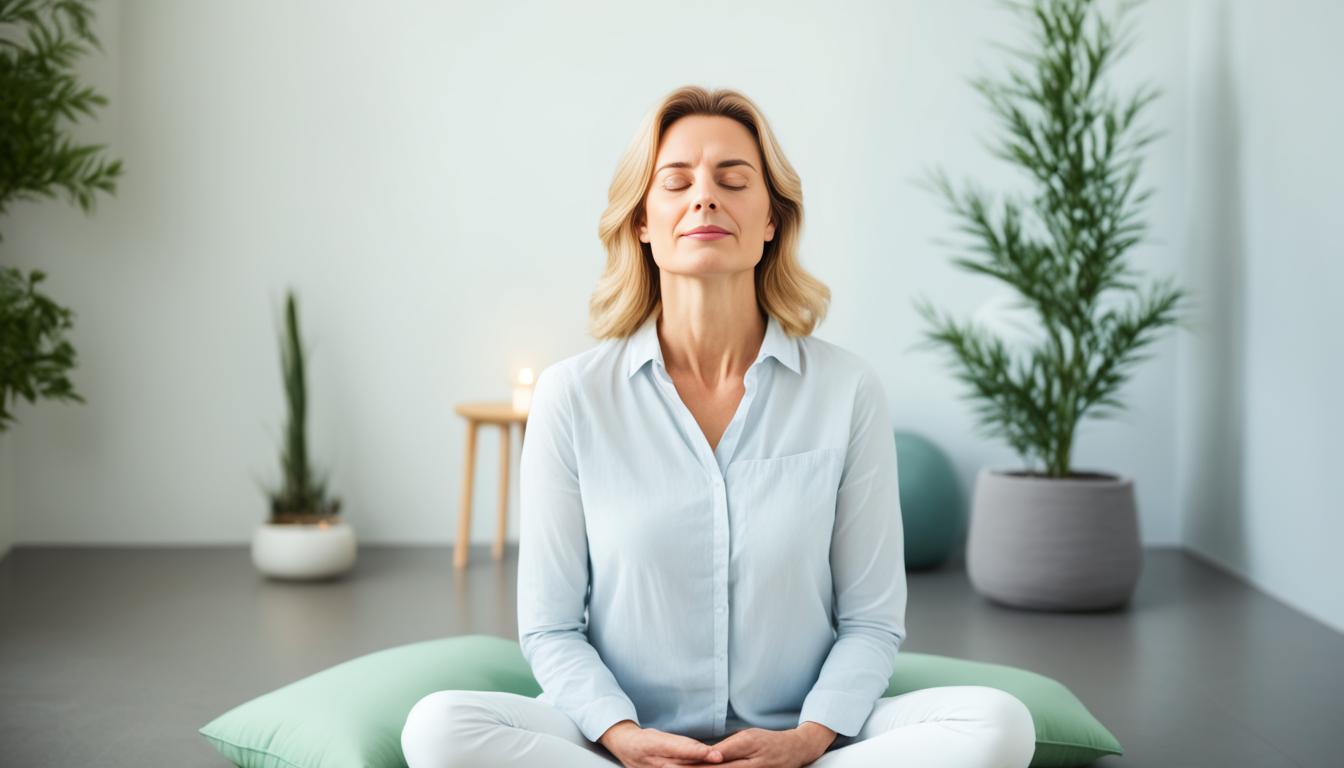Feeling stressed and overwhelmed? Looking for a quick and effective way to calm your mind and relax your body? Look no further than 3-minute meditation techniques. In just a few minutes, you can experience the benefits of meditation and find inner peace.
Meditation has been practiced for centuries and is known for its ability to reduce stress, improve focus, and promote overall well-being. However, many people shy away from meditation, thinking it requires lengthy sessions or complicated techniques. That’s where 3-minute meditation comes in. It offers a simple, accessible, and time-efficient approach to finding calm in the midst of a busy day.
Whether you’re a beginner or have been practicing meditation for years, the techniques in this article can help you quickly find a sense of calm and relaxation. From breathing techniques to overcoming distractions, we’ll guide you through easy-to-learn methods that can be done anywhere, anytime.
Key Takeaways:
- 3-minute meditation techniques offer a quick and accessible way to find calm in your daily life.
- Meditation and mindfulness can reduce stress and improve overall well-being.
- Proper breathing and sitting posture are essential for effective meditation.
- Learn how to overcome distractions and frustrations during meditation.
- Discover quick techniques for instant relaxation in just a few minutes.
Understanding Meditation and Mindfulness
Meditation and mindfulness are powerful practices that can bring calm and clarity to your busy life. When you meditate, you commit to focusing your attention and being fully present in the moment. This intentional awareness helps you cultivate a deep sense of tranquility and clarity, irrespective of the external circumstances.
Mindfulness, on the other hand, is a specific form of meditation that involves paying attention to your thoughts and feelings without any judgment. By observing your inner experiences neutrally, you can develop a greater understanding of your mind and emotions, enhancing your overall well-being.
By integrating meditation and mindfulness into your daily routine, you can experience a range of benefits. These practices have been shown to reduce stress, promote relaxation, and improve overall mental and emotional well-being. Many individuals find that regular meditation helps them cope with daily challenges and cultivate a renewed sense of peace and contentment.
To truly achieve the benefits of meditation and mindfulness, it’s important to learn to let go of thoughts and be fully present in the current moment. By releasing your worries about the past and the future, you can break free from the cycle of stress and find inner peace.
Take a moment now to close your eyes and take a deep breath. Let go of any concerns or distractions, and bring your attention to the sensations in your body. Feel the support of the ground beneath you and notice the gentle rise and fall of your breath, anchoring you to the present moment. Embrace this opportunity to cultivate a deep sense of presence and stillness.

The Power of Connection
Both meditation and mindfulness provide a powerful means of connecting with yourself on a deeper level. They allow you to tune in to your inner experiences, gaining insights and understanding that enable personal growth and transformation. By taking the time to be fully present in your own life, you can nurture a greater sense of self-awareness and develop a stronger connection to the world around you.
Through the practice of meditation and mindfulness, you can tap into a wellspring of peace and wisdom that resides within you. It’s like discovering an oasis in the midst of chaos – a sanctuary where you can retreat to find calm and clarity.
Committing to a regular meditation practice can be a life-changing endeavor. So why not begin today? Set aside a few minutes each day to sit quietly, be still, and connect with your breath. Embrace the transformative power of meditation and mindfulness and experience the profound effects they can have on your well-being.
Mastering the Basics: Breathing and Sitting
Proper breathing is essential in meditation. Many people breathe incorrectly, which can lead to feelings of lightheadedness and discomfort.
“Breathing is the bridge between mind and body.”
To enhance your meditation experience, it’s important to practice deep, intentional breathing. Here is a simple breathing technique that you can incorporate into your meditation practice:
1. Find a comfortable sitting position, whether that’s on a chair, cushion, or the floor.
2. Close your eyes and take a moment to relax your body.
3. Breathe in deeply through your nose, feeling your belly expand as you inhale.
4. Pause briefly at the top of your inhalation.
5. Exhale slowly through your nose, feeling your belly contract as you exhale.
6. Pause briefly at the bottom of your exhalation.
This technique allows you to focus on the sensations of your breath and the rise and fall of your belly, bringing your attention into the present moment. By practicing this breathing technique, you can bring a sense of calm and relaxation to your meditation sessions.
Along with proper breathing, sitting posture is also important for a comfortable meditation practice. Different options are available for finding a sitting position that suits you:
1. Sitting on a chair: Sit with your feet flat on the floor, and your back straight but relaxed. Rest your hands on your thighs or in your lap.
2. Sitting on a cushion: Cross your legs and sit on a meditation cushion or pillow. Keep your back straight and your hands rested on your knees or in your lap.
3. Sitting on the floor: If you prefer sitting directly on the floor, you can use a meditation mat or folded blanket to support your sitting bones. Cross your legs and keep your back straight.
Experiment with different sitting options to find the one that feels most comfortable for you. Remember, the goal is to maintain a relaxed and upright posture that supports your meditation practice.

Mastering proper breathing and sitting posture are foundational skills in meditation. By incorporating these techniques into your practice, you can create a solid foundation for deepening your meditation experience and finding inner peace.
Overcoming Distractions and Frustrations
During meditation, distractions and frustrations are common hurdles that meditators often encounter. It’s normal for thoughts and feelings to arise, pulling your attention away from the present moment. However, by understanding how to approach these experiences, you can navigate through them with ease and find a sense of calm.
Think of distractions and frustrations during meditation as a swinging pendulum. Just like a pendulum swings back and forth, your mind may wander, swinging from one thought to another. But instead of becoming overwhelmed or discouraged, you can use a gentle approach to regain focus and serenity.
“The quieter you become, the more you can hear.”
When distractions arise, acknowledge them without judgment or frustration. Notice their presence, label them as distractions, and gently let them go. Just like clouds passing across the sky, let your thoughts and feelings drift away as you bring your attention back to your breath.
Remember, meditation is a practice, and it’s natural for distractions to occur. It’s not about eliminating distractions but rather learning to refocus your attention. By calmly and compassionately acknowledging distractions, you can cultivate a deep sense of inner peace and mindfulness.
As you continue your meditation journey, be patient with yourself. Distractions and frustrations may still arise from time to time, but each moment offers an opportunity for growth and self-discovery. Embrace the process, and allow yourself to experience the transformative power of meditation.

Refocus Technique: Labeling Thoughts
One effective technique for refocusing your attention amidst distractions is the practice of labeling thoughts. When a thought arises during meditation, instead of getting carried away by its content, simply label it as a “thought” or a “feeling” without attachment or judgment.
Imagine yourself as an observer, calmly witnessing the thoughts arise and dissipate without getting entangled in their stories. This practice cultivates a state of detached awareness, allowing you to let go of distractions and return to the present moment with clarity and ease.
So, the next time distractions and frustrations arise during meditation, remember to approach them with compassion, acknowledging their presence, and gently redirecting your attention back to the breath. By mastering the art of overcoming distractions, you can deepen your practice and discover profound peace within.
Quick Techniques for Instant Relaxation
Looking for quick relaxation and stress relief? Try these two meditation techniques that can bring instant calm to your busy day.
The first technique is inspired by Kundalini Yoga. With this technique, you’ll take a deep inhale and gently exhale between your thumbs, focusing on the cool sensation. This simple breathwork can help you release tension and find a sense of relaxation in just a few minutes.
The second technique is a breath awareness meditation. Find a comfortable seated position, close your eyes, and bring your attention to your breath. As thoughts arise, gently let them go and refocus on the sensation of your breath. This practice allows you to cultivate a sense of presence and let go of stressors that may be weighing you down.

Both of these techniques can be completed in just 3 minutes, making them perfect for quick relaxation during a busy day. Whether you’re at work, at home, or on the go, you can easily incorporate these practices into your routine.
Take a moment to prioritize your well-being and give these quick meditation techniques a try. Experience the power of instant relaxation and stress relief right at your fingertips.
Exploring the Body Scan Meditation
The body scan meditation is a powerful practice that allows you to bring your attention to different parts of your body, noticing sensations and releasing tension. By engaging in this practice, you can cultivate a deep sense of relaxation and presence within your own body.
During the body scan meditation, you will be guided through a step-by-step process of observing your body and allowing it to relax. Start by finding a comfortable position, either sitting or lying down. Close your eyes and take a few deep breaths to center yourself.
Now, bring your attention to the crown of your head. Notice any sensations or areas of tension or relaxation. Slowly move your attention down to your forehead, your eyes, your cheeks, and your jaw. Release any tension you may be holding in these areas, allowing them to soften.
Continue to scan your body, bringing your attention to your neck, your shoulders, and your arms. Notice any sensations, whether it’s warmth, tingling, or tightness. With each breath, release any tension you feel, allowing your muscles to relax and unwind.
Next, bring your attention to your chest and your stomach. Feel the rise and fall of your breath, and notice any sensations in this area. As you exhale, let go of any stress or tension that you may be holding in these regions of your body.
Continue scanning your body, moving down to your hips, your thighs, your knees, and your calves. Pay attention to any sensations you feel, noticing areas of tightness or areas that feel relaxed and at ease. With each breath, let go of any tension and allow your muscles to soften and relax.
Finally, bring your attention to your feet and the tips of your toes. Notice any sensations in this area, whether it’s warmth, tingling, or a sense of groundedness. As you exhale, release any remaining tension and let your feet become completely relaxed.
Take a moment to sit with the sensations in your body. Notice how you feel after completing the body scan meditation. If you’d like, you can slowly open your eyes and come back to the present moment.
The body scan meditation can be practiced in different postures and at any time of the day. It has been shown to reduce stress hormones and promote a sense of deep relaxation. Incorporating this practice into your daily routine can help you reconnect with your body and find a greater sense of peace and well-being.

Conclusion
In today’s fast-paced world, finding moments of calm and relaxation is crucial for your overall well-being. Luckily, 3-minute meditation techniques provide a quick and accessible way to achieve this. By incorporating these practices into your daily routine, you can experience the benefits of stress relief and mindfulness.
Whether you’re new to meditation or have been practicing for years, these 3-minute techniques can help you create a brief relaxation session whenever you need it. The power of a short meditation session lies in its ability to cultivate a sense of instant calm, allowing you to find refuge from the demands of your busy life.
Make it a habit to set aside just a few minutes each day to practice these techniques. Find a quiet space, close your eyes, and focus on your breath. Allow yourself to let go of the stresses and distractions of the day, and embrace the present moment. You’ll be amazed at how a short meditation session can have a profound impact on your overall well-being and mental clarity.
So, what are you waiting for? Take a deep breath, find a comfortable position, and begin your 3-minute meditation practice today. Discover the power of mindfulness and experience the transformative effects it can have on your life.
FAQ
What is meditation?
Meditation is the practice of focusing attention and being present in the moment.
What is mindfulness?
Mindfulness is a form of meditation that involves paying attention to your thoughts and feelings without judgment.
How can meditation and mindfulness help reduce stress?
Meditation and mindfulness can help reduce stress by breaking free from the cycle of stress and finding inner peace.
Why is proper breathing important in meditation?
Proper breathing is important in meditation to avoid discomfort and lightheadedness.
What is the correct breathing technique for meditation?
The correct breathing technique involves breathing in and out through the nose and focusing on the sensations of the breath and the rise and fall of the belly.
How should I sit while meditating?
You can sit on a chair, cushion, or the floor while meditating, depending on your preference and comfort.
What should I do when distractions and frustrations arise during meditation?
When distractions and frustrations arise, acknowledge them and label thoughts and feelings without judgment. Then, refocus your attention on the breath.
What are some quick techniques for instant relaxation?
Two quick techniques for instant relaxation are Kundalini Yoga and breath awareness meditation.
How does the body scan meditation work?
The body scan meditation involves bringing attention to different parts of the body, noticing sensations, and releasing tension.
What are the benefits of 3-minute meditation?
The benefits of 3-minute meditation include stress relief and cultivating mindfulness in our busy lives.
Source Links
- https://www.perpetuaneo.com/how-to-meditate-beginners/
- https://www.mindful.org/a-3-minute-body-scan-meditation-to-cultivate-mindfulness/
- https://anmolmehta.com/3-minute-meditations-for-fast-relaxation/


